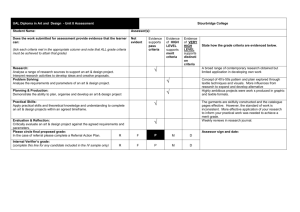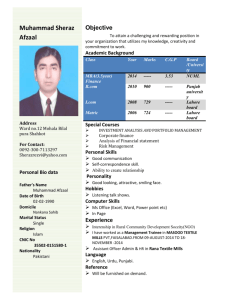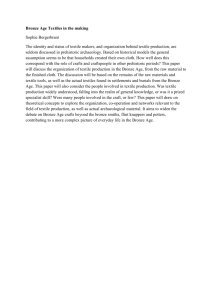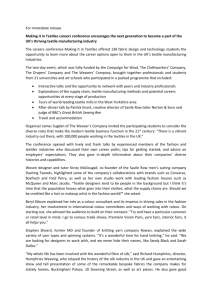Notes on fashion designers´ way of working
advertisement
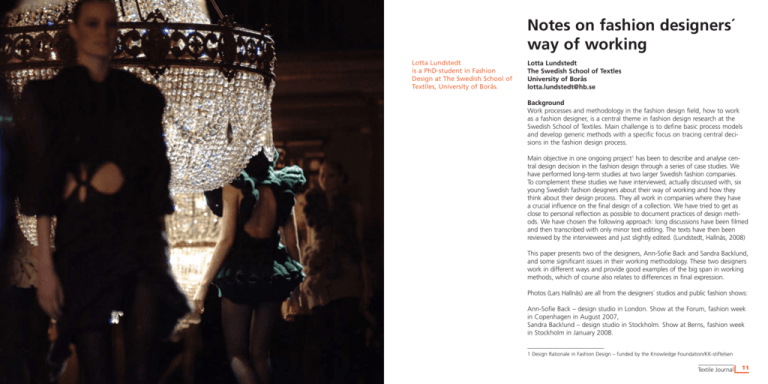
Notes on fashion designers´ way of working Lotta Lundstedt is a PhD-student in Fashion Design at The Swedish School of Textiles, University of Borås. Lotta Lundstedt The Swedish School of Textles University of Borås lotta.lundstedt@hb.se Background Work processes and methodology in the fashion design field, how to work as a fashion designer, is a central theme in fashion design research at the Swedish School of Textiles. Main challenge is to define basic process models and develop generic methods with a specific focus on tracing central decisions in the fashion design process. Main objective in one ongoing project1 has been to describe and analyse central design decision in the fashion design through a series of case studies. We have performed long-term studies at two larger Swedish fashion companies. To complement these studies we have interviewed, actually discussed with, six young Swedish fashion designers about their way of working and how they think about their design process. They all work in companies where they have a crucial influence on the final design of a collection. We have tried to get as close to personal reflection as possible to document practices of design methods. We have chosen the following approach: long discussions have been filmed and then transcribed with only minor text editing. The texts have then been reviewed by the interviewees and just slightly edited. (Lundstedt, Hallnäs, 2008) This paper presents two of the designers, Ann-Sofie Back and Sandra Backlund, and some significant issues in their working methodology. These two designers work in different ways and provide good examples of the big span in working methods, which of course also relates to differences in final expression. Photos (Lars Hallnäs) are all from the designers´ studios and public fashion shows: Ann-Sofie Back – design studio in London. Show at the Forum, fashion week in Copenhagen in August 2007, Sandra Backlund – design studio in Stockholm. Show at Berns, fashion week in Stockholm in January 2008. 1 Design Rationale in Fashion Design – funded by the Knowledge Foundation/KK-stiftelsen 10 Textile Journal Textile Journal 11 Significant for Sandra Backlund’s way of working is the design of the design process (cf. Jones 1992 pp. xxvi and Jones 1998) She creates garments and expressions that strongly relate to the specific working methods she has developed during a number of years. It is a matter of the systematics of confidence, to know when the process is right by learning how to work with creativity. To design the design process and be happy about it refers somehow to a feeling of loosing oneself in the work. Sandra Backlund 12 Textile Journal “I am not going to come up with these ideas in my head, if I just sit and draw. I am only going to do that if I make it with my hands. It has something to do with the brain halves I guess. I cannot imagine these garments that I do. There are so many who have difficulties understanding how I work and how I have come up with the garments. I experimented a lot; I spent a lot of time on that. It is worthwhile also, if you want to get something that is a little unexpected. Then, it is personal, I see I have a personal aesthetic, there is a red thread in what I do, and I make clothes that fit with my personal taste.” “I just know when I’ve found a good shape”. Textile Journal 13 “I just know, I see it when I see it. I cannot think of it before, I cannot draw it; I cannot decide it before. I see it when I see it.” 14 Textile Journal “I work almost always only on the basis of improvisation. It is not that I sit down and think that I should find inspiration, but it may be something that has been a while in my mind, a starting point. It is often very free and nothing that I am strict with. I see it more as a start. It could be the colour or the shape or any other loose idea.” Textile Journal 15 Sandra Backlund includes herself in her work and works with improvisation and composition, training the critical eye that guides intuition (cf. Arnheim 1988 pp. 1-4, 36-50). As Sandra Backlund says “I see it when I see it”. You can se her mannequin or body as a white canvas that she paints with her knitted fabric, she sculptures shapes and volume into wearable art. “Then I get the material and start to improvise with the craftsmanship. I almost always build my clothes, no matter what materials I use, of small pieces; the technique can be compared with collage or sculpture. I never have to go through this process of figuring out how it will work or how to do it. I am very free. Then it is a matter of personal taste when I know, this is good. I do not know exactly how it works but it is what determines how I want it to look like. Try out, try out and try out, I put a lot of time on the pure craftsmanship”. 16 Textile Journal “Then when I have got a few pieces together, I pin them together in different ways, and test how it looks and how I can build forms and use my knitted parts in different ways. I am quite strict. I can say to myself that I only allowed to use these parts. I restrict myself in that freedom, so that the work will not be endless. I can be so strict that even if I see that it would be a better result if I knitted two turns to this piece, I do not allow myself to do it. I am a little bit like that but, I am trying to quit that behaviour, it was a good starting point when I started to design, but there is no reason to compromise on the final product for any kind of geeky matter of principle. I have tried to drop that a bit now.” Textile Journal 17 When Sandra Backlund talks about craft in her work she refers both to techniques and what Jones call a subtle system of efficient work methods. It is design through craft and not design-by-drawing (Jones 1992 pp.15-24). The form is modified by testing, testing – it is sketching and designing by knitting. “I work with some kind of self-therapy. It sounds very strange but there are quite a lot of artists who work like that, if you write poetry or music or paint or whatever you do. There is a need to express oneself or get things out of you.” 18 Textile Textile Journal Journal Textile Journal 19 “I know that we all care about what other people think, but somewhere I believe that I am a very introvert person. Although I obviously care about external things, but this way of working is still just a big ego trip. Maybe I need it to deal with myself, I don’t know.” 20 Textile Journal Textile Journal 21 Ann-Sofie Back 22 Textile Journal “We start designing the garments of “Back”, by selecting garments that don’t feel too rotten to take up again.” ”It’s a pretty good way to start using the new garment types myself before I start to design the next season, then I can stop using the trench coat and think that I just have to have collarless coats. Then I know how it works. -You wear it yourself? Yes exactly, I buy a second hand coat and sew it so that it becomes my own collarless coat, so I do not force a garment type on myself that I don’t like.” Textile Journal 23 Ann-Sofie Back often uses already existing clothes or her previous designs as a starting point for the development and design of new collections. It is a certain form of redesign (cf. Hara 2007 pp. 22-25) and a search for design improvements by searching for visual inconsistency (cf. Jones 1992 pp. 209-213), an act of making the known unknown, to see new things in the old ones. 24 Textile Journal ”It is about what you are inspired by in general, I am inspired by the clichés about fashion or beauty, femininity or sexiness, or how women are depicted in media, things that I have a problem with, something that I dislike. For some reason, I feel that it is more interesting and fun, and more to work with, than to be inspired by butterflies that are beautiful as they are. ” ”I am personally not so amazingly interested in colour. I usually don’t wear any colour, I can only like one colour at a time, and then, I have three garments in that colour, and then, remove them, then I like yellow and then blue. I am not so into colour and form, it doesn’t interest me so much, it’s the idea, and the cutting of garments, it becomes too much information if I use colour also. I think my ideas work best in a rather neutral material and fairly neutral colours. Gray, beige, brown, black, white, neutral colours.” Textile Journal 25 If you are using political fashion (cf. Breward, 2009) etc., as a starting point, ideas are not coming to you automatically every season. You need methods to find ”inspiration”. It is here many designers use thematic frameworks for the collection and go into research about colours and trends. Ann-Sofie Back uses scale drawings in a process of design-by-drawing to develop the design, to predict the outcome (cf. Jones, 1992, pp. 20-24, 64-66), but also to communicate with the design and production teams. ” When I start to sketch, I start drawing the idea of the garments or styles that I used last season, I usually do not renew myself. It is often then I realize that if the trench coat is still a trend, or if it is men’s shirts or blouses, or if it is more feminine. Then I try to force myself to change styles. ” ”The sketch is just so-so, well, it is not fashion drawings we are doing, it is more so-so.” 26 Textile Journal Textile Journal 27 References Arnheim, R, (1988). The power of the center – a study of composition in the visual arts. University of California press. Breward, C. Fashion and Politics - Retrieved April 20, 2009 http://www.showstudio.com Hara, K, (2007). Designing Design. Lars Muller Publishers. Jones, J C, (1998), PhD research in design, Design studies Vol. 19 No 1 January 1998 ”…I have already gone through that, because I have already sketched 40 variations on the idea … and then I selected 3 out that I think would work. So when we start with the pattern, I know if it is possible or not.” 28 Textile Journal Jones, J C, (1992). Design methods. John Wiley & Sons, Inc. Lundstedt, L and Hallnäs, L (2008). Modedesign – samtal med… Centrum för Textil Forskning, CTF. Textile Journal 29



